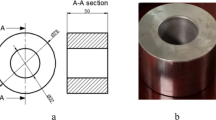Abstract
The 2.5D cutting operations are intended for creating NC programs for components with pockets, lugs, flat sections etc, for which, it is too time consuming to produce a 3D volume model of the component. A 2.5D machining processes can perform the cutting operation only in two of the three axes at a time, the movement of the cutter on the main planes before moves to the next depth produced a terrace-like approximation of the required shape. However, adopting the right cutting parameters could be an ideal solution to improve the product quality. This study focused on optimizing the cutting parameters for higher surface quality in 2.5D cutting utilizing titanium coated carbide ball end mill. These parameters include; machined surface inclined angle, axial depth of cut, spindle speed and feed rate. Taguchi optimization method is the most effective method to optimize the cutting parameters, in which the most significant response variables could be identified. The standard orthogonal array of L9 (34) is used, while the signal to noise (S/N), target performance measurement (TPM) response analysis and analysis of variance (Pareto ANOVA) methods are carried out to determine which parameters are statistically significant. Finally, confirmation tests are carried out to investigate the optimization improvements.
Similar content being viewed by others
References
Black, J. T. and Kohser, R. A., “Materials and Processes in Manufacturing,” John Wiley & Sons, 2008.
Lee, Y. S. and Chang, T. C., “Application of computational geometry in optimizing 2.5D and 3D NC surface machining,” Computers in Industry, Vol. 26, pp. 41–59, 1995.
Pang, J. and Narayanaswami, R., “Multiresolution offsetting and loose convex hull clipping for 2.5D NC machining,” Computer-Aided Design, Vol. 36, pp. 625–637, 2004.
Yao, Z. and Gupta, S. K., “Cutter path generation for 2.5D milling by combining multiple different cutter path patterns,” International Journal of Production Research, Vol. 42, pp. 2141–2161, 2004.
Gupta, S. K., Saini, S. K., Spranklin, B. W., and Yao, Z., “Geometric algorithms for computing cutter engagement functions in 2.5D milling operations,” Computer-Aided Design, Vol. 37, pp. 1469–1480, 2005.
Hamdan, A., Sarhan, A. D., and Hamdi, M., “An optimization method of the machining parameters in high-speed machining of stainless steel using coated carbide tool for best surface finish,” The International Journal of Advanced Manufacturing Technology, Vol. 58, No. 1–4, pp. 81–91, 2012.
Ramanujam, R., Muthukrishnan, N., and Raju, R., “Optimization of cutting parameters for turning Al-SiC(10p) MMC using ANOVA and grey relational analysis,” Int. J. Precis. Eng. Manuf., Vol. 12, No. 4, pp. 651–656, 2011.
Saini, S., Ahuja, I., and Sharma, V., “Influence of cutting parameters on tool wear and surface roughness in hard turning of AISI H11 tool steel using ceramic tools,” Int. J. Precis. Eng. Manuf., Vol. 13, No. 8, pp. 1295–1302, 2012.
Sarhan, A. A. D. and Matsubara, A., “Compensation Method of the Machine Tool Spindle Thermal Displacement for Accurate Monitoring of Cutting Forces,” Materials and Manufacturing Processes, Vol. 26, No. 12, pp. 1511–1521, 2011.
Raju, K., Janardhana, G., Kumar, P., and Rao, V., “Optimization of cutting conditions for surface roughness in CNC end milling,” Int. J. Precis. Eng. Manuf., Vol. 12, No. 3, pp. 383–391, 2011.
Munawar, M., Chen, J.-S., and Mufti, N., “Investigation of cutting parameters effect for minimization of sur face roughness in internal turning,” Int. J. Precis. Eng. Manuf., Vol. 12, No. 1, pp. 121–127, 2011.
Zhang, J. Z., Chen, J. C., and Kirby, E. D., “Surface roughness optimization in an end-milling operation using the Taguchi design method,” Journal of Materials Processing Technology, Vol. 184, pp. 233–239, 2007.
Sayuti, M., Sarhan, A. D., Fadzil, M., and Hamdi, M., “Enhancement and verification of a machined surface quality for glass milling operation using CBN grinding tool-Taguchi approach,” The International Journal of Advanced Manufacturing Technology, Vol. 60, No. 9–12, pp. 939–950, 2012.
Ghani, J. A., Choudhury, I. A., and Hassan, H. H., “Application of Taguchi method in the optimization of end milling parameters,” Journal of Materials Processing Technology, Vol. 145, pp. 84–92, 2004.
Park, S. H., “Robust Design and Analysis for Quality Engineering,” Chapman & Hall, 1996.
El-Gallab, M. and Sklad, M., “Machining of Al:SiC particulate metal matrix composites Part II: Workpiece surface integrity,” Journal of Materials Processing Technology, Vol. 83, pp. 277–285, 1998.
Dogra, M., Sharma, V., Sachdeva, A., Suri, N., and Dureja, J., “Tool wear, chip formation and workpiece surface issues in CBN hard turning: A review,” Int. J. Precis. Eng. Manuf., Vol. 11, No. 2, pp. 341–358, 2010.
Author information
Authors and Affiliations
Corresponding author
Rights and permissions
About this article
Cite this article
Pa, N.M.N., Sarhan, A.A.D. & Shukor, M.H.A. Optimizing the cutting parameters for better surface quality in 2.5D cutting utilizing titanium coated carbide ball end mill. Int. J. Precis. Eng. Manuf. 13, 2097–2102 (2012). https://doi.org/10.1007/s12541-012-0277-y
Received:
Accepted:
Published:
Issue Date:
DOI: https://doi.org/10.1007/s12541-012-0277-y




